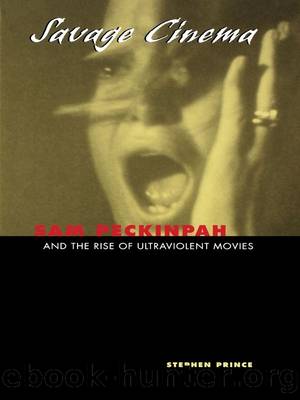Savage Cinema: Sam Peckinpah and the Rise of Ultraviolent Movies by Stephen Prince

Author:Stephen Prince [Prince, Stephen]
Language: eng
Format: azw3
Publisher: University of Texas Press
Published: 2010-01-01T00:00:00+00:00
Peckinpah insisted, intensely, that the viewer suffer from witnessing the aggression and brutality that the narrative of Straw Dogs unleashes. The narrative is coherent (barring the complications that the extra footage introduces in the European cut) and is uncompromised by the sentimentality that surrounds the violence in The Wild Bunch. Straw Dogs is a controlled film in which Peckinpah commanded his material and lacerated the viewer with a punishing vision of the savage costs of violence. Like The Wild Bunch, Straw Dogp concludes with an extended violent montage, but with a signal difference indicative of the greater sophistication with which Peckinpah was now approaching the subject of violence and its artistic representation. The montage showing the siege and Davidâs response to his attackers is not an extended, uninterrupted visual spectacle, as is the final montage in The Wild Bunch where the climactic shoot-out at Mapacheâs headquarters is so visually overwhelming that it demolishes the possibility of the viewerâs adopting a critical perspective on the action. The viewer can only submit to its ferocity.
In Straw Dogs, Peckinpah interrupted the violent action of the siege with interludes in which David quarrels with Amy and treats her brutally and converses with the attackers outside. As the differing moral perspectives of the characters collide during these interludes, Peckinpah was able to open up the violent action through irony and by sustaining Davidâs character disorder through the siege itself. As a result, though the siege is harrowing, the viewer is granted a more critical space from which to witness the violence, something Peckinpah failed to provide in The Wild Bunch. When, for example, Amy withdraws her loyalties from David and threatens to open the door to Tom Heddenâs gang of assailants, David grabs her by the hair and brutally pulls her back. His action, and her pained response, visualized in slow motion, identify David with her rapist, Charlie, demonstrating Davidâs own viciousness. By punctuating the power of his montages with these critical interludes, Peckinpah was able to avoid losing control of his material as he did in The Wild Bunch.
Peckinpah followed Straw Dogs with the genial, relaxed, and delightful Junior Bonner and with The Getaway, a rare attempt to make a solidly commercial picture. In Junior Bonner, he celebrated, via comedy and nostalgia, the vanishing West, the wranglers and riders he remembered from his boyhood, and offered a sustained and compassionate portrait of a memorably dysfunctional family. With these shifts of focus, Peckinpah moved away from the inquiry into violence that had brought him such explosive attention on previous productions. As an action picture, The Getaway features abundant violence, some of it quite nasty, but here Peckinpah subordinated style to narrative more completely than in most of his other films. As a result, The Getaway offers visceral images of violence but does not inquire into, or explore, their meaning. The violence in the film is mainly, and merely, physical. It lacks the interior correlates that he so brilliantly provided in his other films.
With these pictures
Download
This site does not store any files on its server. We only index and link to content provided by other sites. Please contact the content providers to delete copyright contents if any and email us, we'll remove relevant links or contents immediately.
Call Me by Your Name by André Aciman(20371)
Ready Player One by Cline Ernest(14524)
How to Be a Bawse: A Guide to Conquering Life by Lilly Singh(7391)
Wiseguy by Nicholas Pileggi(5671)
The Kite Runner by Khaled Hosseini(5083)
On Writing A Memoir of the Craft by Stephen King(4863)
Audition by Ryu Murakami(4850)
The Crown by Robert Lacey(4723)
Call me by your name by Andre Aciman(4619)
Gerald's Game by Stephen King(4581)
Harry Potter and the Cursed Child: The Journey by Harry Potter Theatrical Productions(4440)
Dialogue by Robert McKee(4321)
The Perils of Being Moderately Famous by Soha Ali Khan(4169)
Dynamic Alignment Through Imagery by Eric Franklin(4116)
Apollo 8 by Jeffrey Kluger(3637)
Seriously... I'm Kidding by Ellen DeGeneres(3577)
The Inner Game of Tennis by W. Timothy Gallwey(3575)
How to be Champion: My Autobiography by Sarah Millican(3555)
Darker by E L James(3477)
